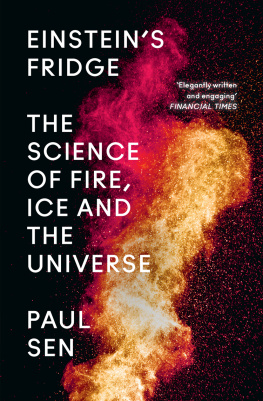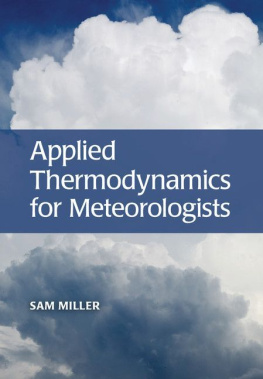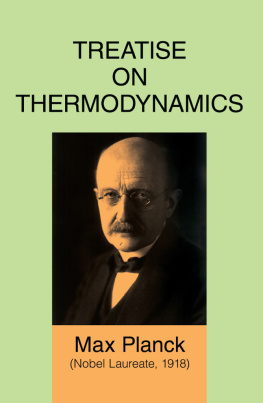Three Laws of Nature
Three Laws of Nature
A Little Book on Thermodynamics
R. Stephen Berry

Published with assistance from the foundation established in memory of Philip Hamilton McMillan of the Class of 1894, Yale College.
Copyright 2019 by R. Stephen Berry.
All rights reserved.
This book may not be reproduced, in whole or in part, including illustrations, in any form (beyond that copying permitted by Sections 107 and 108 of the U.S. Copyright Law and except by reviewers for the public press), without written permission from the publishers.
Yale University Press books may be purchased in quantity for educational, business, or promotional use. For information, please e-mail sales.press@yale.edu (U.S. office) or sales@yaleup.co.uk (U.K. office).
Set in Janson Roman type by Integrated Publishing Solutions. Printed in the United States of America.
ISBN 978-0-300-23878-5 (hardcover : alk. paper)
Library of Congress Control Number: 2018954948
A catalogue record for this book is available from the British Library.
This paper meets the requirements of ANSI/NISO Z39.48-1992
(Permanence of Paper).
10 9 8 7 6 5 4 3 2 1
Contents
ONE
What Is Thermodynamics?
The First Law
TWO
Why We Cant Go Back in Time
The Second and Third Laws
THREE
How Did Classical Thermodynamics Come to Exist?
FOUR
How Do We Use (and Might We Use) Thermodynamics?
FIVE
How Has Thermodynamics Evolved?
SIX
How Can We Go Beyond the Traditional Scope of Thermodynamics?
SEVEN
What Can Thermodynamics Teach Us About Science More Generally?
Preface
This book has a very specific purpose: to use the science of thermodynamics as a paradigm to show what science is, what science does and how we use it, how science comes to exist, and how science can evolve as we try to reach and address more and more challenging questions about the natural world. It is intended primarily for people with little or no background in science, apart, perhaps, from some exposure in school or college to science for everyone courses.
The approach, quite frankly, came from three stimuli. One was a course I gave for non-scientist undergraduates at the University of Chicago that evolved over years. The second was an adult education course that grew out of that undergraduate coursebut was at a somewhat lower level, primarily in terms of the mathematics. The third, first in time, which had a very crucial influence on that evolution, was a pair of essays published in 1959 by the British scientist and novelist C. P. Snow, titled The Two Cultures, based on lectures he had given at Cambridge University. Snow said, in essence, that those who belong to the culture of scientists know vastly more about the culture of humanities than the reverse, and that this is a serious problem for our society. He argued, metaphorically, that if we were to achieve a proper balance, the non-scientists would know as much about the second law of thermodynamics as the scientists know about Shakespeare. In a later essay, actually published in 1964 with the first two, he retreated and replaced the second law of thermodynamics with contemporary biology.
I might have disagreed with his change even then, but as biology has advanced it is very clear that, in our time, he was right in the first place. Why? To understand biology today, one must learn many, many facts, but one needs very few facts to understand thermodynamics. It is a subject rooted in a few concepts, far more than on systematic inferences from vast amounts of information, as contemporary biology is now.
This book is written for people who are interested in what science is and does, and how it comes to be, but who have little or no prior substantive knowledge of any science. In writing for this audience, there was a clear choice to be made regarding the order of the chapters. Would the ideas be clearer if the history came first, or if the first thing one read was the substance of the science as it is today? I have chosen the latter. Thus I first show, , address the question of how we arrived where we are.
The first two chapters develop an overview of what the traditional science of thermodynamics is, of the concepts that embody it, and how it uses these concepts. These chapters are built around the three laws of thermodynamics, namely the conservation of energy, the inevitability and direction of change with time, and the existence of a limiting absolute zero of temperature.
The third chapter presents the history of the science. There we see how the concepts, the variables, and the tools that we call the laws of thermodynamics evolved. This is important because some of the concepts of thermodynamics are so ubiquitous and pervasive in our thinking and language that they seem obvious and trivially simple to us, where, in reality, they evolved only with great difficulty, and remain in many ways amazingly subtle and not so simple at all. That history has been, and even still is, a tortuous but fascinating path, especially when we understand where and what thermodynamics is today. And it offers a rich insight into how a science evolves, often having to resolve competing, conflicting concepts.
The fourth chapter describes the ways we apply thermodynamics, especially how we use information from this science to improve the performances of many things we do in everyday life. The fifth chapter describes the way the science of thermodynamics has continued to evolve since its pioneers established its . Despite the elegant and in many ways the most natural presentation of the subject, in a formal, postulational and essentially closed format, the subject has continued to undergo evolutionary changes, expanding and strengthening as new discoveries require that we extend our concepts. A crucial advance discussed in this chapter is the connection between the macroscopic approach of traditional thermodynamics and the microscopic description of the world, based on its elementary atomic building blocks. This link comes via the application of statistics, specifically through what is called statistical mechanics.
The sixth chapter examines the open challenges that we face if we wish to build upon the thermodynamics we now have to provide us with tools to go beyond, to other, still more difficult and usually more complex problems of how nature functions. It addresses questions of whether and when there are limits to what a particular science can tell us, and whether inferences we make using the tools and concepts of a science can sometimes have limits of validity. This chapter reveals how this science continues to offer new challenges and opportunities, as we recognize new questions to ask.
The seventh and final chapter addresses the question of how thermodynamics, one particular example of a kind of science, can show us what a science is and does, and hence why we do science at all. This chapter is a kind of overview, in which we look at how thermodynamics can serve as a paradigm for all kinds of science, in that it reveals what scientific knowledge is, how it differs from knowledge in other areas of human experience, how scientific knowledge, as illustrated by thermodynamics, has become deeply integrated into how we live, and how we can use scientific knowledge to help guide human existence.
A comment directly relevant to the intent and content of this book: Thermodynamics is the science most likely to be true. This is a paraphrase of a comment made by Albert Einstein; he was putting thermodynamics in the larger context of all of science. Einstein certainly recognized that every science is always subject to change, to reinterpretation, even to deep revision; he himself was responsible for such deep changes in what had been accepted as scientific laws. His comment reflects his belief that thermodynamics contains within itself aspectsconcepts and relationsthat are unlikely to require deep revision, unlike the way quantum theory revised mechanics and relativity revised our concepts of space and gravitation. Was he right?
Next page













